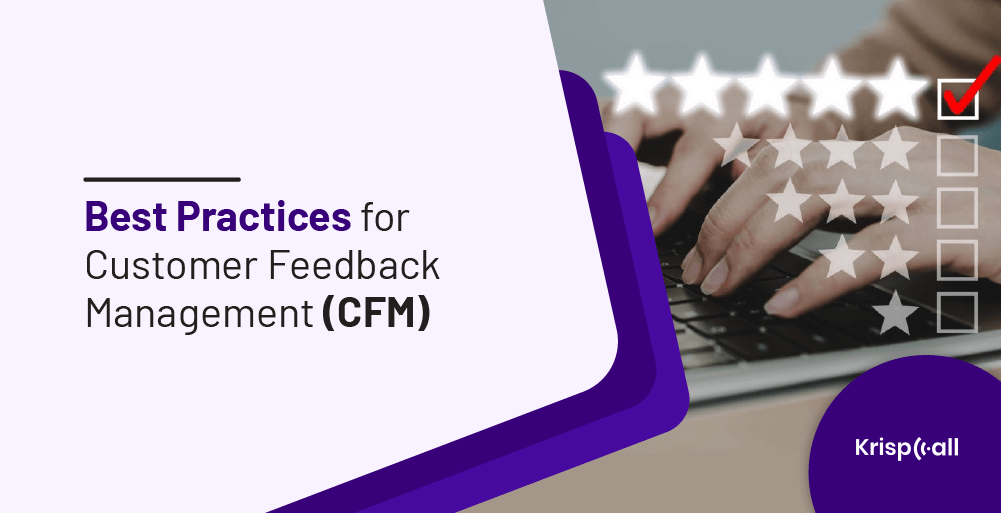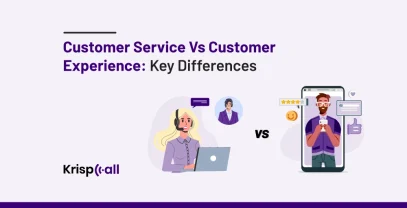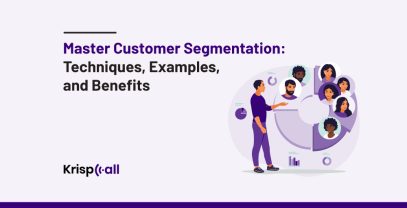A loyal customer can bring you more sales than any marketing campaign. On the other hand, an unsatisfied customer can cost you more than just sales. What do you do to stay on top of ever-changing customer expectations?
By asking them, i.e., through customer feedback.
Customer feedback is a summary of what they think about a product or service. Using this feedback, you can discover the degree of customer satisfaction and understand where improvements could be made in product development and customer success by your business.
Customer feedback is thus considered one of the best and easiest ways to gain insight into the things that matter to your business. You can gain information such as: which parts of your business do customers like and dislike?
Further to any delay, let’s dive into the best practices for Customer Feedback Management. In addition to that, you’ll also learn:
- What is Customer Feedback Management? What are its types?
- Why Customer Feedback Management is important for your business?
- 9 Best Customer Feedback Best Practice
Best Practices for Customer Feedback Management (CFM)
Implementing a structured customer feedback management process helps you break down your customer feedback and identify actionable insights that can have an advantage in your business.
CFM (Customer Feedback Management) enables you to disentangle the data and make data-driven decisions that improve your customer experience and build lifelong relationships with customers.
There are 9 best practices you can follow for managing customer feedback.
1. Define your Objectives
You will be able to narrow down your efforts if you define your objectives at the beginning of your feedback process. The feedback tool market is flooded with intuitive and easy-to-use tools that can easily be integrated into your support function.
You may become overly excited by the idea of learning what your clients think of you. If you do this, you end up with lengthy and arbitrary customer data that is tough to parse for patterns.

As we know that customer feedback can be collected for an entire customer experience, a specific touchpoint, or even for new product development, it is very important to identify the reason for executing the customer feedback survey.
Thus, it is important to define your objectives at the beginning of the process. Also, keep your surveys to a limited number so that you don’t overwhelm your customers. Make sure to only ask for feedback when it is really needed.
2. Tailor the Feedback Process to your Objectives
There are many customer survey metrics available on the market today, and it is your decision to select the one that best aligns with the objectives that you have defined in the previous step.
Some customer survey metrics give you a holistic predictive analysis that gives you information on how likely your customers are to recommend your product or service to other customers.
While some metrics provide you with information on the percentage of customers that are satisfied with your entire service or a fraction of it.
Also, some survey metrics measure the amount of effort you need to put on a customer to tempt them into taking some actions to flourish your business. Thus, you must be very specific about choosing a feedback approach that is most relevant to the growth of your business.
3. Collect Feedback across Multiple Channels
These days, collecting feedback is so easy, thanks to modern technology. As internet usage and social media have become ubiquitous, surveys have gone beyond traditional phone calls.
By using simple tools, you can turn any platform into your survey channel. This could be a mobile app, pop-up, or social media.
The in-app surveys will help you pinpoint specific usability issues (e.g., Was [insert feature] easy to use?), whereas the website pop-up survey will help you measure the overall experience (e.g., What is your overall rating of the website pop-up survey?).
Each channel serves a different purpose. It is therefore beneficial to collect feedback from multiple channels.
4. Categorize the Feedback Collected
Customer feedback surveys using multi-channels are insightful and easy to set up when partnered with CRM and survey software. Thus, we are left with the question of how are the feedback channels categorized. The best way is to group them into two categories: support and product feedback.
5. Support Feedback
As far as competition is concerned, customer support is still the key differentiator in 2024. Providing exceptional customer service is not a puzzle to be solved. All it takes is high expectations, constant improvisation, and exceptional listening skills.
A recent online survey found 33% of customers might lose trust in your brand after one negative experience, and the rest might leave after two to three negative experiences.
Fortunately, you don’t need a crystal ball to read your customers’ minds. You just have to listen to them and act accordingly.
6. Product or User Experience Feedback
We can further divide product feedback into technical issues and feature issues. Technical issues can mean a major bug in a product, a malfunction, a server issue, or a simple form submission problem.
The product team should immediately address the technical issues since they may prevent your customer from accessing some of your most important features.

Issues with features are generally requests, such as adding a search function to your blog or adding a wishlist tab to your landing page. These requests are rarely urgent.
You can’t find these customer insights anywhere else, so they are extremely valuable and relevant. The qualitative feedback you get from these questions can be extremely valuable and relevant. They bring the voice of the customer to the frontline during product feature development.
7. Track Behaviour to Optimize the Feedback Loop
A timely response to feedback is vital to ascertain the effectiveness of your efforts. It’s important to keep track of when is the best time to collect customer feedback, which channel generates the most responses, and which feedback management tool you should use.
Performing surveys too often will result in indifferent customer responses, and conducting surveys irregularly will result in missed opportunities.
There are some companies that evaluate surveys by demographics to cater to audiences across time zones. Thus, you must spend time optimizing your feedback collection processes and keep an eye out for new trends.
8. Use Feedback for Internal Brainstorming
Customers are full of great and innovative ideas. Each customer journey and each feedback are unique. Also, the feedback provided by the customer is not intended to be trend-driven or market-research-driven. It should rather focus on making your product and service better.
It is important to use customer feedback to spark internal brainstorming within your organization. Customer feedback can help restore balance in a room filled with contradictory opinions – because the customer’s viewpoint is almost always correct.
9. Establish a Formal VOC Program
VOC refers to collecting customer feedback, analyzing it, and actively incorporating it into your business growth strategy. The introduction of a formal VOC program will keep the whole feedback process from being randomized. This will ensure active cross-functional participation throughout the organization.
When companies have valuable insights into customer sentiment, customer effort, and other major customer satisfaction metrics, they can better predict customers at risk of churn and act quickly to increase customer retention and improve satisfaction.
Therefore, you should do more than thank your customers for their feedback. You can transfer templates for personalized acknowledgment messages to your customers every time they give you feedback. Inform them about progress. And most importantly, act on the feedback you receive for greater customer success.
What is Customer Feedback Management? What are its types?
Customer feedback management (CFM) is the systematic process of collecting, analyzing, and utilizing customer feedback to drive business growth and enhance customer satisfaction.

Through CFM, businesses can gain valuable insights into customer needs, preferences, and pain points by gathering feedback from various communication channels, including social media, product reviews, and surveys.
The different types of customer feedback are:
- Direct Customer Feedback
- Indirect Customer Feedback
- Transactional Feedback
- Behavioral Feedback
Why Customer Feedback Management is important for businesses?
Customer Feedback Management is important for all types of businesses to improve their customer satisfaction, cultivate loyalty, and make businesses grow sustainably. Businesses can attain valuable insights into customer needs and pain points by obtaining and analyzing feedback from various channels.
There are many benefits of customer feedback management in businesses like:
- Helps to reduce churn
- Increase business revenue
- Builts better customer relationships
- Enhance products or services
The Ninja Technique
A bad customer experience can make your clients and customers pull back from using your products and services. But it may not always be easy to deliver them on the first go either. Hearing what they truly need is the first step to improving customer experience and avoiding losing clients.
Despite all the modern technology and various communication platforms, phones haven’t yet turned obsolete. People still make phone calls to contact businesses to request products and services. And oftentimes, they make phone calls to tell their requirements, express their dissatisfaction, or file a complaint regarding your products and services.
So you need to have a reliable telephony system to receive requests and feedback and address them accordingly. But that being said, not all telephony services have the same features or quirks.
Enhance your customer experience by using KrispCall
Some of them are specially designed to deliver a good experience to your customers. For this very purpose, they are loaded with a good number of customer feedback management features.
One such telephony platform is KrispCall. It’s a cloud-based phone system with a plethora of useful features for smooth business communications and easy customer feedback management.
To avoid any dissatisfaction from customers, it’s crucial to hear what they have to say. Noting down all the details on a piece of paper may not be so effective in this regard.
Sometimes, the information can be misinterpreted, and sometimes such papers can get lost causing chaos in the organization. To avoid that, KrispCall has included call recording feature in its cloud telephony app.
For such occasions, using features like customized greetings, auto attendant, call forwarding and call transfer, intelligent call routing, etc. can come in handy. Furthermore, KrispCall’s cloud telephony platform supports CRM integration as well.
To identify the customers and their requirements and issues, there is also an option in KrispCall’s Unified Callbox. You can not just add names and addresses of the customers but also group similar kinds of customers using call and contact tags. You can also add more information through call notes.
With these features, KrispCall makes the customer feedback management process effective and efficient. But it’s not the features and easy user interface that make KrispCall exceptional. It offers an affordable pricing range and can also use it free for a 15-day trial period.
KrispCall offers a Schedule Free KrispCall demo now for first-time users. So you can get started and explore the features on your own without spending a penny.
FAQ
What are the customer satisfaction metrics needed for your business?
The customer satisfaction metrics needed for your business are:
- Net Promoter Score
- Customer Satisfaction Score (CSAT)
- Customer Churn Rate
- Customer Lifetime Value
- Customer Effort Score (CES)





